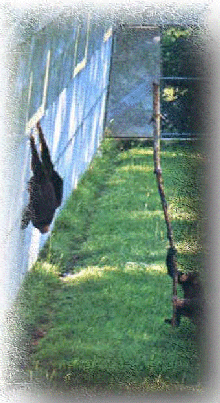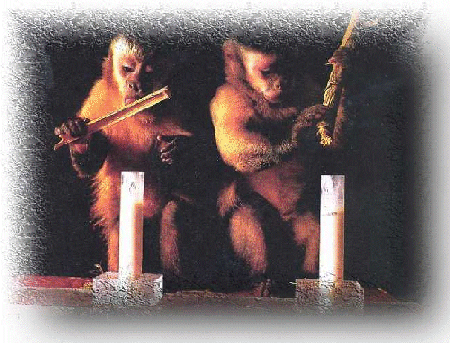While manipulating poles
in their play, the chimpanzees learned to use the poles to escape from their
enclosure. One chimp spontaneously utilized the pole in order to obtain something from
a high shelf. From the example of this chimp's use of the pole as a tool, the other
chimps learned the use of the poles for escaping. The group learning of these
chimpanzees illustrates the importance of imitation in learning and tool use. This
behavior is included as tool use because, although it occurred in captivity, it was not
the result of imitation or observation of human activity.
obtain something from
a high shelf. From the example of this chimp's use of the pole as a tool, the other
chimps learned the use of the poles for escaping. The group learning of these
chimpanzees illustrates the importance of imitation in learning and tool use. This
behavior is included as tool use because, although it occurred in captivity, it was not
the result of imitation or observation of human activity.
The researchers observed that the chimpanzees
were very selective about the poles which they used as climbing tools. They
discarded old pieces of wood which might break, ones which were too long and cumbersome
for carrying, and ones which were too short. Chimps show sophisticated tool use in
that they can modify objects to form tools. For example, they have been observed
joining two sticks together to make a longer tool for reaching high places.
In Tanzania, chimps construct tools from grass
and twigs which they use to extract ants from their holes. Wild chimps have also
been observed using sticks to withdraw honey from beehives, dig up edible roots, and as
levers to open boxes of bananas left by scientists. Leaves are also used as tools by
chimps for collecting water and for wiping mud, blood, and sticky fruit from their bodies.
The role of imitation in chimpanzee tool use is
explained by research conducted by Jane Goodall. Young chimps learn how to break
twigs from trees, strip away the leaves, and insert them into termite holes by observing
adults. The steps required to extract termites in this manner are lengthy and
complex. Without the demonstrations of adults, many chimps would probably never
become very successful termite fishers. However, part of the acquisition of this
tool use appears to relate to innate characteristics of chimpanzee behavior. All
young chimpanzees amuse themselves by playing with sticks and poking them into holes.
It seems as though the chimps are able to observe the more skilled adults and
translate their juvenille play into a successful means for securing food.
Chimpanzees may venture as far as 90 meters
from a termite hill in search of a tool to extract the termites. Some chimpanzees
also bring numerous sticks back to the termite mound to use as spares. While termite
or ant-fishing, the chimps stand on two feet, as far away from the nest as possible in
order to avoid being bitten. Another method which the chimps use to avoid being
bitten is to insert the stick into the termite hole while elevated in a tree or
vine. Gombe chimpanzees have a special technique for determining whether a branch or
termite mound is worth probing. The Gombe chimps insert a blade of grass into the
mound and determines the quantity of ants from the scent of the extracted blade.

Hooded monkeys
demonstrate similar to those of the chimpanzees. These monkeys were faced with the
challenge of extracting yogurt from narrow plastic tubes. The tubes were too small
to probe with their fingers and were bolted to the table to prevent the monkeys from
pouring out the contents. The hooded monkeys cleverly fashioned spoons from pieces
of wood which were available in the experiment room.